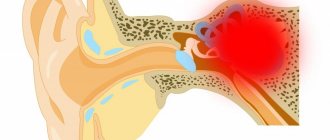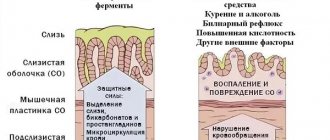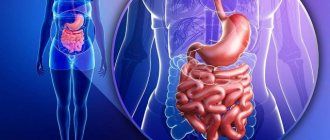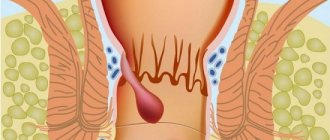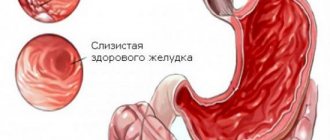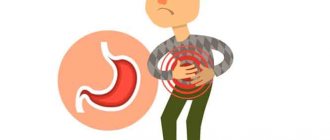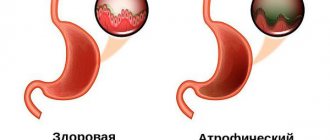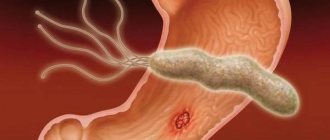Acute gastritis is usually understood as an inflammatory process affecting the gastric mucosa, caused by the negative influence of aggressive external factors, presented in the form of strong irritants. These include alcoholic beverages, unstable emotional state, and poor diet.
Against the background of gastritis, the normal functioning of the stomach is disrupted, resulting in a disorder of the digestive system. Patients with this disease must seek help from a gastroenterologist, otherwise the likelihood of complications increases.
Acute gastritis
An acute form of inflammation of the stomach occurs a short period of time after exposure to negative factors on the mucous membrane of the organ.
Severe symptoms, including abdominal pain and indigestion, also occur quickly. Kinds:
- Fibrinous gastritis is an inflammation of the mucous membrane that occurs against the background of acid poisoning or a severe infectious disease.
- Catarrhal gastritis is an inflammation that occurs due to poor nutrition. It manifests itself as damage to the cells of the mucous membrane and migration of leukocytes to the site of inflammation.
- Necrotizing gastritis is a severe form of inflammation that occurs when various chemicals enter the organ. The disease is characterized by destruction of the mucous membrane and deeper tissues of the stomach walls.
With timely treatment, the acute form of the disease is characterized by a favorable prognosis.
FAQ
Is superficial gastritis dangerous?
Any disease is dangerous in its own way, especially if it is associated with inflammation of internal organs. Superficial gastritis is no exception. We must not forget that the inflammatory process tends to spread, so damage to superficial tissues can soon spread to the next, deeper tissues. Of course, superficial gastritis itself is not life-threatening. Its danger lies in the development of complications and aggravation of the disease, which, in the absence of proper treatment, will necessarily transform into a more complex pathology. Therefore, the disease cannot be ignored: it is better, easier and faster to cure the incipient process than to subsequently deal with serious consequences.
If pain with superficial gastritis becomes constant, pulsating, independent of food intake, the development of complications should be suspected.
Does superficial gastritis occur in children and how does it manifest?
Unfortunately, the development of gastritis in childhood is not uncommon. The peak incidence occurs in the age category from 5 to 6 years, as well as from 9 to 12 years, which may be associated with periods of rapid development of the child’s body.
Inflammation of the superficial mucous tissue in children is most often associated with the following reasons:
- infection with pathogenic flora Helicobacter;
- taking medications incorrectly;
- nutritional disorders (poor quality food, overeating);
- food allergies;
- viral and infectious diseases;
- parasitic infestations.
Superficial acute gastritis in childhood can easily progress deep into the tissue, even to the point of necrosis. Therefore, at the first signs of damage to the gastrointestinal tract in a child, it is necessary to urgently take action by seeking medical help.
Chronic gastritis
The chronic form of the pathology can occur independently or against the background of acute gastritis. Symptoms of the disease are not always pronounced, so inflammation can develop over many years. The most common cause of chronic gastritis is Helicobacter pylori infection.
Types of chronic gastritis:
- Autoimmune. Inflammation of the stomach occurs due to disruption of the body's defense systems.
- Reflux form, which occurs when the contents of the small intestine are constantly refluxed into the stomach.
- Bacterial form. Long-term invasion of Helicobacter pylori leads to dystrophic changes in the inner lining of the organ.
Doctors also distinguish other forms of chronic gastritis, including radiation and eosinophilic. To accurately determine the etiology of the disease, the results of instrumental and laboratory examinations are necessary.
Helicobacter pylori
In the second half of the 20th century, a previously unknown factor was identified, which today is considered one of the first places in the etiology of chronic gastritis. Helicobacter pylori is a spiral-shaped gram-negative bacterium that infects various areas of the stomach and duodenum. Many cases of gastric and duodenal ulcers, gastritis, duodenitis, and possibly some cases of gastric lymphoma and gastric cancer are etiologically associated with Helicobacter pylori infection. The successful experience with self-infection of one of the discoverers of the role of Helicobacter pylori in the development of diseases of the stomach and duodenum - Barry Marshall and a group of volunteers served as convincing evidence of this theory. In 2005, Barry Marshall and his colleague Robin Warren were awarded the Nobel Prize in Medicine for their discovery.
However, the majority (up to 90%) of infected Helicobacter pylori carriers do not show any symptoms of disease. Not every chronic gastritis has a bacterial cause.
Causes
Gastritis is a polyetiological disease. In 90% of cases, inflammation of the stomach occurs against the background of Helicobacter pylori invasion into the mucous membrane of the organ. The activity of the bacterium leads to the gradual destruction of the protective film of the stomach, as a result of which hydrochloric acid begins to damage the epithelium and other tissues. The bacterium is found in the stomach of almost every second person, but not all people's carriage causes damage to the organ.
Other reasons:
- An acute bacterial infection that occurs when E. coli, staphylococcus or streptococcus penetrate an organ.
- Other types of infectious diseases, including tuberculosis and candidiasis.
- Reflux disease of the gastrointestinal tract, characterized by the reflux of the contents of the duodenum into the stomach. Bile acids and other substances can damage the walls of the organ.
- Poisoning with acids, alkalis, heavy metals, salts and other chemicals that damage the tissues of the gastrointestinal tract.
- Inflammatory and autoimmune processes in other parts of the digestive system, including chronic duodenitis and Crohn's disease.
- Adverse effects of drugs. Damage to the gastric mucosa can occur while taking non-steroidal anti-inflammatory drugs, glycosides, corticosteroids and some antibiotics.
- Bad habits. Alcohol and substances contained in tobacco smoke irritate the mucous membranes of organs.
- An allergic reaction in which the body attacks the lining cells of the stomach.
The factors listed above cause the development of the disease in most cases.
Classification
Several options for dividing superficial gastritis have been accepted.
By localization
Based on location, it is divided into the following types:
- distal;
- fundic (bottom of the stomach);
- gastritis of the organ body;
- pangastritis - localization is all mucous membranes;
- distal - in the lower part of the organ, where food is excreted into the duodenum.
Inflammation can be localized in any part of the stomach
By stages
In order to more accurately characterize the diagnosis, it is customary in medicine to conventionally divide superficial gastritis into stages.
Mild, or superficial gastritis of the 1st degree, is characterized by the spread of inflammatory tissue changes to the mouths of the pyloric glands. At the same time, the number of atrophied cells is minimal.
Moderate, or superficial gastritis of the 2nd degree, is accompanied by inflammatory phenomena not only of the superficial, but also of the middle glandular tissues. The number of atrophied cells is increased compared to stage 2 gastritis.
Severe, or superficial gastritis of the 3rd degree, is a lesion of the entire mucous membrane of the gastric wall down to the muscle layer. The number of atrophically altered cellular structures is sharply increased.
With the flow
Thus, there are chronic, recurrent, and active forms of superficial gastritis.
The chronic form most often develops as a consequence of an untreated acute form of the disease. But in some cases it can occur independently, as a result of an unhealthy diet that does not correspond to the capabilities of the stomach. Symptoms are often atypical, hidden and may not cause suspicion in the patient. The secretory function of the digestive system during chronic conditions may remain the same. This form is characterized by periodic exacerbations, which can be perceived by the patient as the beginning of an acute illness.
This is what the mucous membrane looks like in a section with chronic superficial gastritis
An exacerbation in most cases resembles a normal acute inflammatory process. Characteristic signs of exacerbation are unpleasant belching, nausea to vomiting, increased gas formation, sharp pain in the stomach, discomfort and a feeling of heaviness in the epigastrium.
Active gastritis is a phase of active inflammatory process, which is usually observed in the initial stage of the disease, as well as during exacerbation. With prolonged activity of the inflammatory reaction, the pathology can, after some time, move from superficial tissues to deeper layers. In this case, gastritis ceases to be superficial: a full-fledged inflammatory process in the stomach occurs with all the ensuing adverse consequences.
Risk factors
In addition to the above reasons for the formation of gastritis, it is worth paying attention to the risk factors for the disease. These are conditions associated with lifestyle, heredity and the patient’s individual history.
Main risk factors:
- Poor nutrition. Excessive consumption of fatty, spicy or salty foods increases the risk of developing gastritis. In addition, carbonated drinks, crackers, chips and other types of fast food are harmful to the gastrointestinal tract.
- Prolonged stress. A psychological state can affect the organ by affecting the secretion of gastric juice. With chronic stress, acid is constantly released in the stomach.
- Elderly age. The pathology is most often diagnosed in men and women over 60 years of age.
- Diseases that negatively affect the immune system. First of all, these are HIV infection and congenital immunodeficiencies.
- Unfavorable heredity. Predisposition to the disease can be transmitted to the patient from parents.
Taking risk factors into account allows for effective preventive measures.
Symptoms
Manifestations of the disease depend on the form of inflammation. Symptoms of acute gastritis occur suddenly against the background of exposure to negative factors on the stomach. Patients complain of pain in the upper abdomen, nausea and vomiting. Pain is also characterized by chronic gastritis with increased secretory activity of the organ, since with this disease an excess amount of hydrochloric acid is formed. Inflammation with a decrease in the secretory activity of the stomach most often manifests itself as mild symptoms.
Additional symptoms:
- pain in the chest and neck area (heartburn);
- constant belching;
- loss of appetite;
- frequent urge to defecate;
- decreased performance;
- insomnia;
- bloody vomiting;
- black stool (melena);
- white coating on the tongue;
- bloating;
- worsening mood.
If any of the above symptoms appear, you must make an appointment with a gastroenterologist.
Complications
Without treatment, acute or chronic gastritis can cause a variety of complications. Some negative consequences of the pathology can threaten the patient's life.
Possible complications of gastritis:
- Ulcerative lesions of the stomach and small intestine.
- Gastrointestinal bleeding. Symptoms of this complication include pale skin, weakness, sweating, dizziness and low blood pressure.
- Perforation of the organ wall with the risk of extensive inflammation.
- Megaloblastic anemia, manifested by weakness, constant fatigue and dizziness.
- Malignant neoplasm of the stomach.
Dangerous negative consequences of acute inflammation can occur within several days.
Diagnostics
In most cases, detecting gastritis is not difficult. To undergo a comprehensive examination, you must make an appointment with a gastroenterologist. The doctor will ask the patient about complaints and examine medical history. A general examination sometimes reveals external manifestations of the disease. The diagnosis is made after analyzing the results of instrumental and laboratory examinations. If acute abdominal pain occurs due to a gastrointestinal disorder, a doctor can be called to your home.
Examination methods used:
- Esophagogastroduodenoscopy is a standard examination method for suspected gastritis or gastric ulcer. The doctor asks the patient to lie on his side and open his mouth wide. The root of the tongue is treated with lidocaine, after which a flexible tube equipped with a camera and a light source is inserted into the gastrointestinal tract. During the examination, the doctor can examine the condition of the mucous membrane of the stomach and intestines by looking at the monitor. This is the most informative type of diagnosis.
- A biopsy of the gastric mucosa is the collection of a small number of organ cells for subsequent histological examination and determination of the cause of the disease. A painless biopsy is usually performed during an esophagogastroduodenoscopy.
- X-ray of the organ. A contrast agent is first injected into the stomach. The resulting image helps to detect indirect signs of inflammation.
- Study of the acid-base state of the stomach contents (pH-metry). This study helps determine the type of gastritis and evaluate the effectiveness of therapeutic treatment of the disease.
- Breath test to detect bacterial gastritis. Using a special device, the concentration of carbon in exhaled air is assessed. An excess of this substance indicates Helicobacter pylori infection.
If necessary, your doctor may need additional tests, including blood tests and an ultrasound examination of the digestive system. The use of several diagnostic methods allows a specialist to prescribe more effective and safe treatment.
Treatment
The treatment regimen is selected by the doctor after determining the factor that caused the inflammatory process and clarifying the form of the disease. You can read more about modern methods of treating gastritis in the article:. Without fail, along with drug therapy, the patient is prescribed a therapeutic diet. Strict cessation of smoking, alcoholic beverages, certain medications and junk food is required. The recommended diet for gastritis also depends on the form of inflammation.
Prescribed medications:
- Antibiotics necessary to eliminate Helicobacter pylori infection. It is possible to prescribe several antibiotics simultaneously along with proton pump inhibitors and bismuth-based drugs. Other types of stomach infections are treated with anti-inflammatory or antifungal medications.
- Protective drugs that protect the gastric mucosa from adverse effects. Enveloping agents help prevent acid from attacking the walls of the organ. Doctors usually prescribe acid-neutralizing antacids to patients. These drugs cannot be used on an ongoing basis, so the course must be limited.
- Medicines that affect the secretory function of the organ. First of all, these are proton pump inhibitors and H2-histamine receptor blockers, which are required for excess gastric acidity. These medications normalize the condition of the organ within 24 hours. Pepsin supplementation is required when gastric secretory activity is insufficient.
Additional medications used for other forms of gastritis include corticosteroids, sorbents and antidotes. In severe cases, the patient may require infusion therapy and surgical treatment. It is important to remember that the main method of preventing the disease is a healthy diet.
Drugs to suppress Helicobacter type bacteria
Metronidazole
A broad-spectrum antibiotic that suppresses most pathogenic bacteria. To achieve an adequate therapeutic response, adult patients are recommended to take 500 mg of the active substance three times a day. When included in combination therapy with other antibiotics, dosages can be adjusted individually for each patient. The recommended course of treatment with an antimicrobial agent is seven days, after which Metronidazole is completely discontinued. In rare cases, therapy lasts for two weeks.
Flagyl
It is also a fairly strong antimicrobial drug, which is most often used in combination therapy with Clarithromycin. Patients with Helicobacter type bacteria are prescribed 500 mg of Flagyl three times a day. The duration of elimination of harmful organisms can be from one to two weeks, taking into account the response to the treatment.
Clarithromycin
The use of antibiotics can be carried out in several schemes. For monotherapy, 0.25 g of medication is prescribed twice a day after the main meal. In combination therapy, it may be recommended to take 0.5 g of the active substance twice a day. If you have problems with the kidneys and liver, you should select doses as carefully as possible so as not to provoke an exacerbation. Therapy using Clarithromycin can last for 1-2 weeks.
This group of drugs should be taken only with a confirmed test for Helicobacter-type bacteria, since they have a fairly aggressive effect on the entire digestive system. Typically, a combination of several antibiotics is used to suppress harmful organisms.


